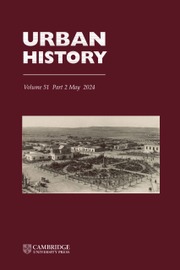Article contents
The Map in Urban History*
Published online by Cambridge University Press: 09 February 2009
Extract
To the historian the map has traditionally been used as little more than a descriptive or illustrative device which helped clarity of exposition by enabling events to be located, campaigns comprehended and treaties interpreted. It was not in itself regarded as a critical instrument of analysis, other than in highly specialized, peripheral studies such as the history of exploration. Maps simply illustrated arguments based on documentary evidence; the map as a document, original or secondary, was regarded with great suspicion. Undoubtedly the inaccuracy of early maps was partly to blame, especially to an historian more concerned with delineatory accuracy than with what was contemporary perception of the world. But even if historical maps were acceptable in evidence, the derivation of conclusions from mapped material was barely permissible and usually, in reviews, the subject of severe warning if not actual stricture. These attitudes have largely disappeared over the last decade in line with changes in direction of historical research. Perhaps the earlier influence came from pre-historic archaeology, where in the nature of things there was no documentary evidence and inference had to be made from the distribution of characteristic artifacts. This, in itself, taking its methodology from geographical or locational analysis, has been translated into a study adopting sophisticated methods for the analysis of distribution patterns. Another important influence has been the majestic work of H. C. Darby in interpreting Domesday in cartographic terms and thereby demonstrating the significance of such an approach to a widely known historical document. Even so, it is in urban history that the use of map evidence and mapped material has made the greatest impact.
- Type
- Research Article
- Information
- Copyright
- Copyright © Cambridge University Press 1979
Footnotes
In the spring of 1978 Jim Dyos invited Professor Carter to review A Comparative Atlas of America's Great Cities for the Urban History Review. It was subsequently suggested that the review should form part of a longer consideration of the use of maps in urban studies directed particularly towards those historians whose experience of mapping and knowledge of cartography were limited. The present paper is the consequence.
References
1. Clarke, D. L., Analytical Archaeology (1968).Google Scholar
2. The most appropriate reference is to the last volume: Darby, H. C., Domesday England (1977).Google Scholar
3. Mumford, L., The Culture of Cities (reprinted 1940), 6.Google Scholar
4. Darlington, I. and Howgego, J. L., Printed Maps of London circa 1553–1850 (1964); Ralph Hyde, Printed Maps of Victorian London 1851–1900 (1975).Google Scholar
5. Tooley, R. V., Maps and Map Makers (1949).Google Scholar
6. For discussion see Close, C. F., The Early Years of the Ordnance Survey (1926);Google Scholar Winterbotham, H. St. J. L., ‘The national plans’, O.S. Professional Papers, xvi (1934);Google Scholar and Harley, J. B., The Historian's Guide to Ordnance Survey Maps, Standing Conference for Local History (1964).Google Scholar
7. Munby, L. M., ‘Tithe apportionments and maps’, in Munby, L. M. (ed.), Short Guides to Records No. 20 (1972), Historial Association.Google Scholar
8. Lynam, E. W. O., British Maps and Mapmakers (1944), 12–16;Google Scholar Emission, F. G., ‘Estate maps and surveys’, in Munby, L. M. (ed.), Short Guides to Records No. 4 (1963).Google Scholar
9. Harley, op. cit., 12.
10. For a note on John Wood see Hyde, R. and Moir, D. G., ‘John Wood Surveys’, Journal of the Society of Archivists (1976), 328.Google Scholar
11. Rowley, G., ‘A source of elementary spatial data for town centre research in Britain’, Area viii, 3 (1976), 201–8, esp. 202–3Google Scholar, and Aspinall, P. J., ‘The use of nineteenth century fire insurance plans for the urban historian’, Local Historian xi, 6 (1975), 343–9.Google Scholar
12. The titles of the volumes are: 1. Urban Development in Central Europe (1964); 2. Urban Development in the Alpine and Scandinavian Countries (1965); 3. Urban Development in Southern Europe: Spain and Portugal (1967); 4. Urban Development in Southern Europe: Italy and Greece (1969); 5. Urban Development in Western Europe: France and Belgium (1970); 6. Urban Development in Western Europe: Great Britain and the Netherlands (1971); 7. Urban Development in East Central Europe (1972), 8. Urban Development in Eastern Europe (1972)Google Scholar
13. The titles of the volumes are: 1. Antiquity 2. Moyen Age; 3. Renaissance et temps modernes; 4. Epoque contemporaine.
14. For example, Dickinson, G. C., Statistical Mapping and the Presentation of Statistics (1963);Google Scholar Toyne, P. and Newby, P. T., Techniques in Human Geography (1971), Chap. 3, ‘Visual representation of data’.Google Scholar
15. See Binford, Henry C., ‘Never trust the census taker, even when he's dead’, Urban History Yearbook (1975).Google Scholar
16. Jenks, G. F. and Coulson, M. R., ‘Class intervals for statistical maps’. International Yearbook of Cartography iii (1963), 120.Google Scholar
17. See Carter, H. and Wheatley, S., Merthyr Tydfil in 1851: A study of Spatial Structure (S.S.R.G. Project, Social and Residential Areas of Merthyr Tydfil in the Mid-Nineteenth Century, Working Papers 2 and 3).Google Scholar
18. For examples applied to mid-nineteenth century data see Holmes, R. S., Continuity and Change in a mid-Victorian resort: Ramsgate, 1851–1871. Univ. of Kent. Unpub. Ph.D., 1977.Google Scholar
19. A useful brief commentary is in Johnston, R. J., Multivariate Statistical Analysis in Geography (1978), 263.Google Scholar
20. Balchin, W. G. V., ‘Graphicacy’, Geography lvii, 3 (1972), 185–95.Google Scholar
- 4
- Cited by


